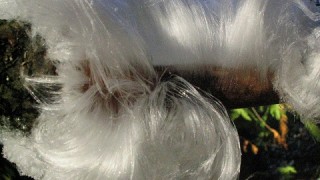
A team of European researchers has recently uncovered the mysteries surrounding the formation of “hair ice.” Also known as “ice wool” or “frost beard,” hair ice typically amasses on dead wood, adopting the appearance of a piece of white candy floss.
In the early 1900s, meteorologist Alfred Wegener conjectured that the spectacular growth originated from some type of fungus - a hypothesis that was later supported by the work of researchers Gerhart Wagner and Christian Mätzler.
Wagner, who is now a retired professor, confirmed the relationship between the ice and fungus. After dipping rotten wood samples in fungicide or high temperature water, he found that the hair ice’s growth was retarded.
Now, researchers from Germany and Switzerland say they have discovered the exact fungus responsible for triggering these peculiar blooms - exidiopsis effusa. Struck by the beauty of hair ice, Mätzler, of the University of Bern’s Institute of Applied Physics, said the team started out conducting simple tests, like letting the structures melt away in their hands.
Working alongside chemist Diana Hofmann and biologist Gisela Preuß, Mätzler set about trying to understand the conditions necessary for cultivating hair ice.
In doing so, the group used microscopy to study samples collected from the forest regions of Brachbach, Germany. While Preuß identified a total of 11 species of fungi, only exidiopsis effusa colonized every sample. However, half of all samples contained e. effusa, exclusively.
Meanwhile, turning his attention to samples obtained from the Moosseedorf forest in Switzerland, Mätzler sought to understand the physics behind the phenomenon. His findings suggest that “ice separation” plays a fundamental role in the development of hair ice.
When liquid water makes contact with cold air, a frozen “crystallization nucleus” forms along the wood’s surface. These structures draw water out from the pores of the wood, eventually leading to the formation of 0.01 millimeter-thick strands of ice.
Parts of lignin and tannin - constituents that play a structural and protective role in vascular plants - were discovered in melted samples of hair ice. It’s believed the fungus may possess an arsenal of enzymes that are capable of eroding lignin. The fungus also stabilized the ice hair structures by secreting recrystallization inhibitors.
The study, entitled Evidence for biological shaping of hair ice, was published in a recent issue of the open access journal Biogeosciences.
